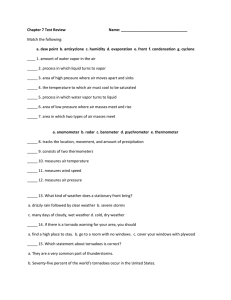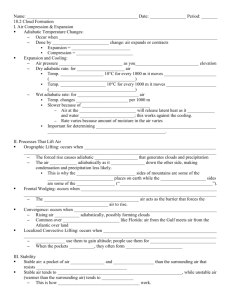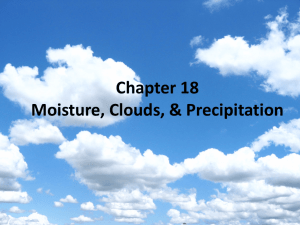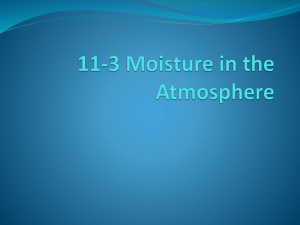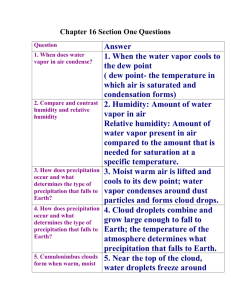SG_ES_ch18
advertisement
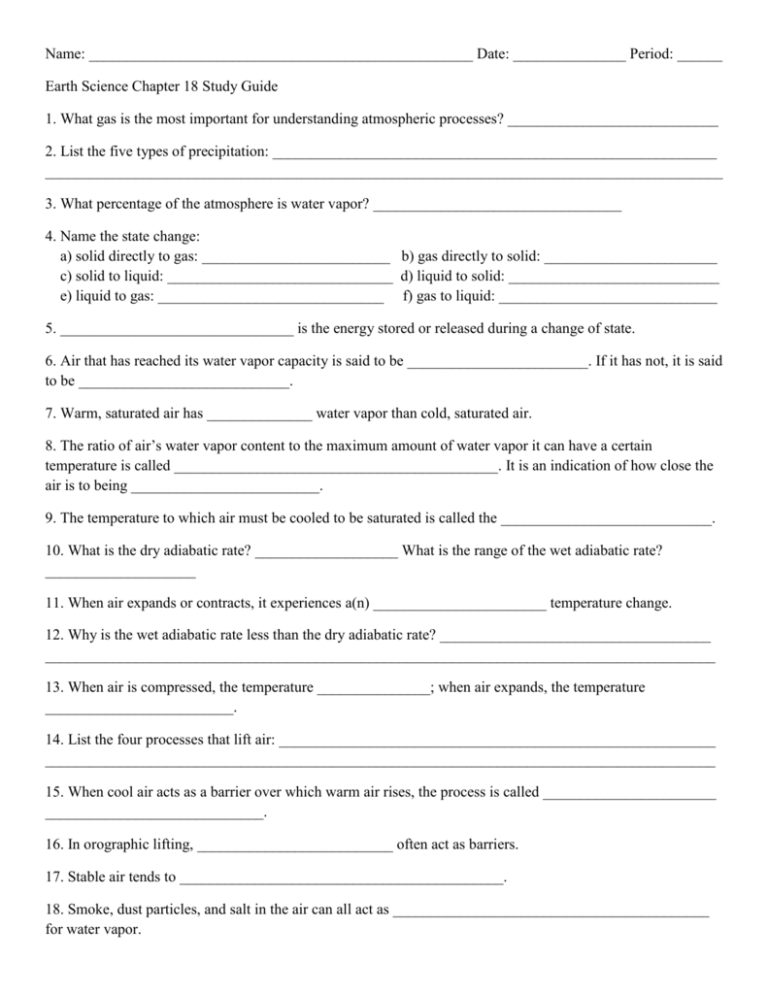
Name: ___________________________________________________ Date: _______________ Period: ______ Earth Science Chapter 18 Study Guide 1. What gas is the most important for understanding atmospheric processes? ____________________________ 2. List the five types of precipitation: ___________________________________________________________ __________________________________________________________________________________________ 3. What percentage of the atmosphere is water vapor? _________________________________ 4. Name the state change: a) solid directly to gas: _________________________ b) gas directly to solid: _______________________ c) solid to liquid: ______________________________ d) liquid to solid: ____________________________ e) liquid to gas: ______________________________ f) gas to liquid: _____________________________ 5. _______________________________ is the energy stored or released during a change of state. 6. Air that has reached its water vapor capacity is said to be ________________________. If it has not, it is said to be ____________________________. 7. Warm, saturated air has ______________ water vapor than cold, saturated air. 8. The ratio of air’s water vapor content to the maximum amount of water vapor it can have a certain temperature is called ___________________________________________. It is an indication of how close the air is to being _________________________. 9. The temperature to which air must be cooled to be saturated is called the ____________________________. 10. What is the dry adiabatic rate? ___________________ What is the range of the wet adiabatic rate? ____________________ 11. When air expands or contracts, it experiences a(n) _______________________ temperature change. 12. Why is the wet adiabatic rate less than the dry adiabatic rate? ____________________________________ _________________________________________________________________________________________ 13. When air is compressed, the temperature _______________; when air expands, the temperature _________________________. 14. List the four processes that lift air: __________________________________________________________ _________________________________________________________________________________________ 15. When cool air acts as a barrier over which warm air rises, the process is called _______________________ _____________________________. 16. In orographic lifting, __________________________ often act as barriers. 17. Stable air tends to ___________________________________________. 18. Smoke, dust particles, and salt in the air can all act as __________________________________________ for water vapor. 19. Name the cloud type: a) sheets or layers that often cover the entire sky: _______________________________ b) globular cloud masses with a cauliflower-like structure: ___________________________ c) low cloud that blankets the whole sky often brings rain: ______________________________ d) cloud sheet or layer in the middle height range: _________________________________ e) any type of “rain” cloud has this as a root word of its name: _________________________ f) clouds associated with thunder and lightning and hail: _________________________________ g) high level, wispy clouds: __________________________ 20. What is the difference between clouds and fogs? ______________________________________________ _________________________________________________________________________________________ 21. What are the two processes that produce precipitation? a) _______________________________________________ b) type(s) of precipitation produced: _________________________________ c) _______________________________________________ d) type(s) of precipitation produced: _________________________________ 22. Part of the Bergeron process relies of supercooled cloud droplets freezing upon contact with ___________________________________________. 23. The Bergeron process occurs in _______________ clouds; the collision-coalescence process occurs in ______________ clouds. 24. Describe the air conditions that produce sleet: _________________________________________________ _________________________________________________________________________________________



